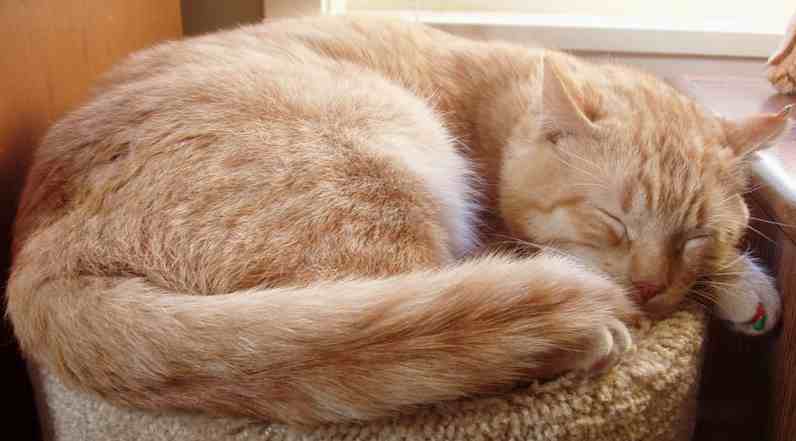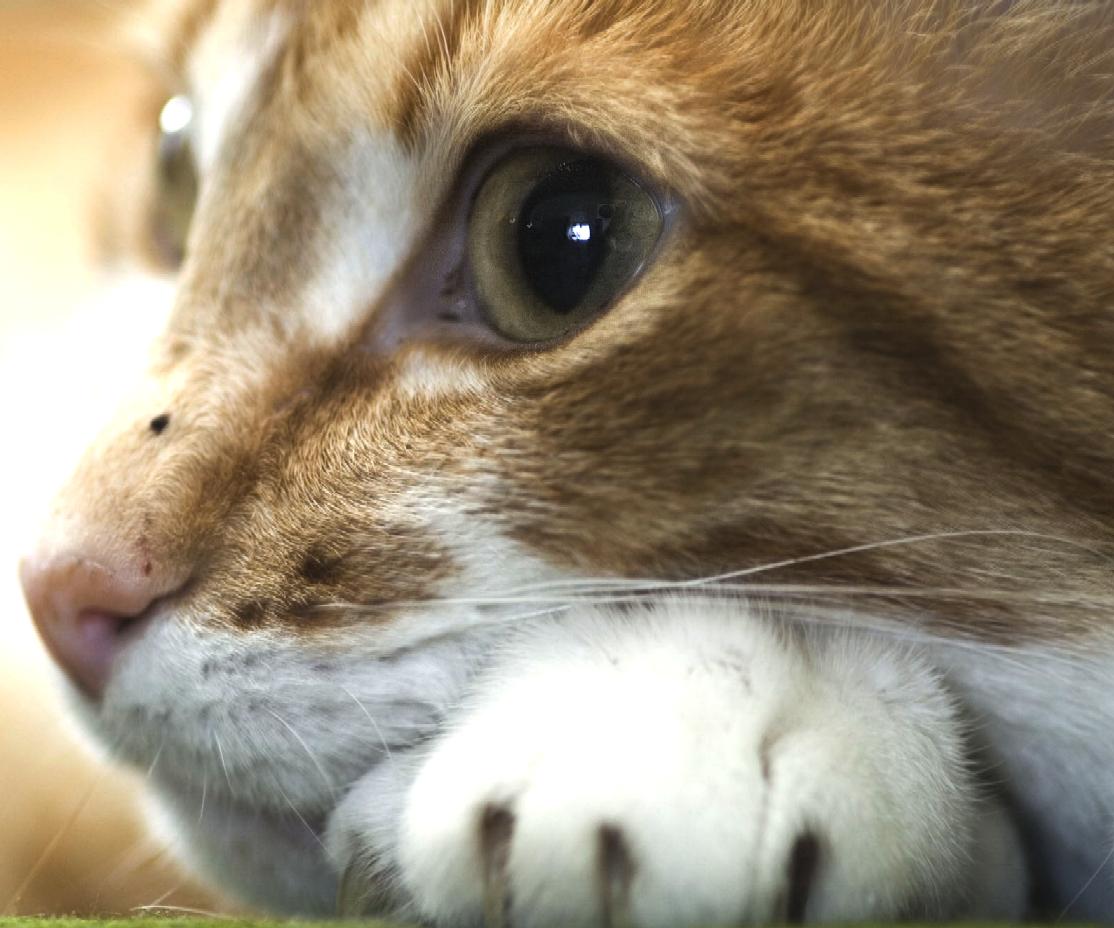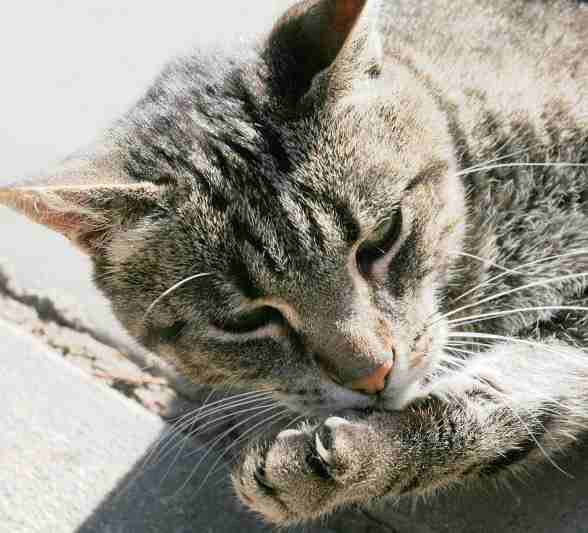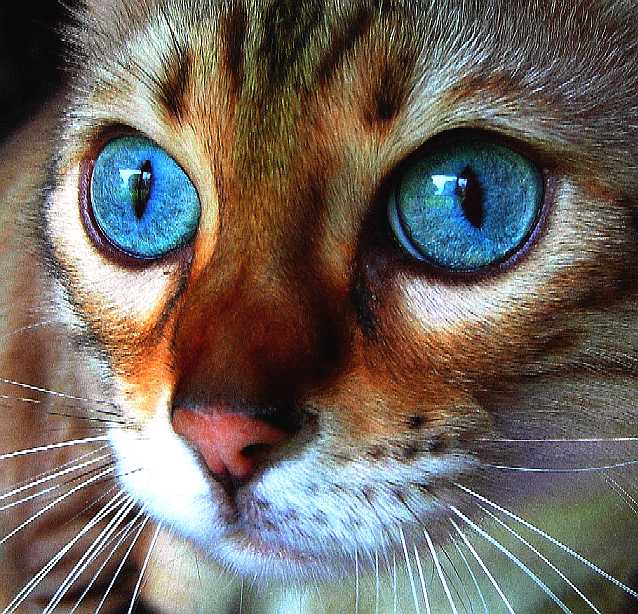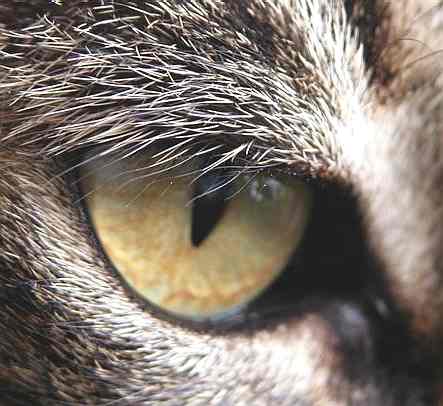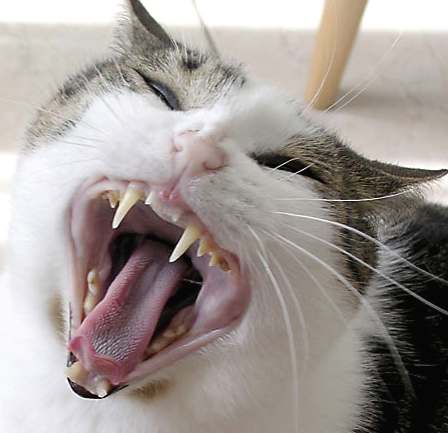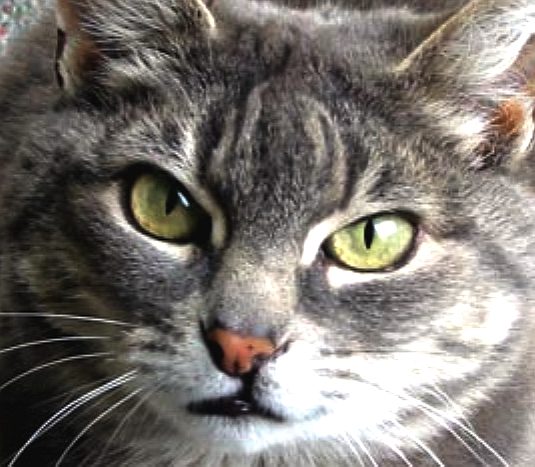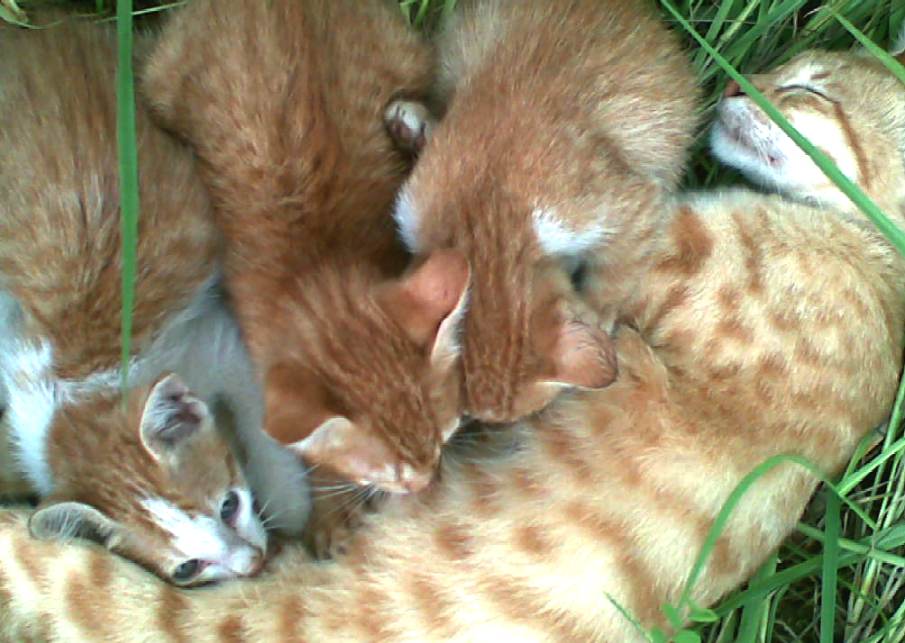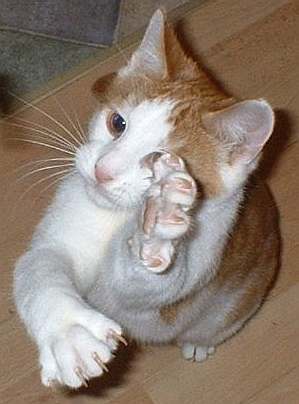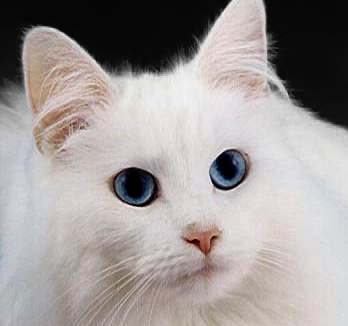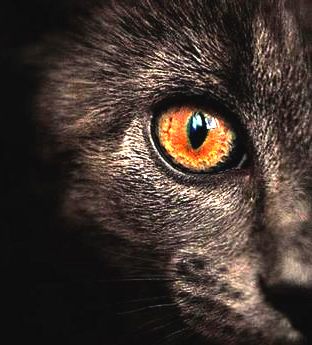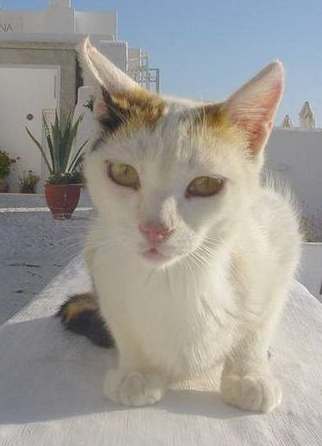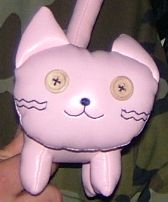|
CATS
|
||||||||||||||||||||||||||||||||||||||||||||||||||||
|---|---|---|---|---|---|---|---|---|---|---|---|---|---|---|---|---|---|---|---|---|---|---|---|---|---|---|---|---|---|---|---|---|---|---|---|---|---|---|---|---|---|---|---|---|---|---|---|---|---|---|---|---|
|
What graceful and independent creatures they are. Full of character, every one. Predators and scavengers, the domestic cat is a marvel of opportunistic social evolution that captivated the Ancient Egyptians totally - leading to their domestication sacred status and the Egyptian Mau. They are also very effective hunters, part of their charm, with all the tools to survive - and they have the occasional bad day, just like us - so be nice to your cat and s-he'll will love you back.
Orange tabby taking a "cat nap"
The cat, also called the domestic cat or house cat, is a small carnivorous mammal of the subspecies Felis silvestris catus. Its most immediate pre-domestication ancestor is believed to be the African wild cat, Felis silvestris lybica and both species have 38 chromosomes. The cat has been living in close association with humans for somewhere between 3,500 and 8,000 years.
There are dozens of breeds of cat, some hairless or tailless as a result of mutations, and they exist in a variety of different colors. They are skilled predators and have been known to hunt over one thousand different species for food. They are also intelligent animals, and some can be trained or learn by themselves to manipulate simple mechanisms such as lever-handled doors and flush toilets.
They communicate by calling ("meow"/"miaou"), purring, hissing, growling, chirping, clicking, grunting, and about a hundred other vocalizations and body language. Cats in colonies use a mix of vocalizations and body language to communicate with each other.
Much like some other domesticated animals (such as the horse), cats may also still live effectively in the wild. Contrary to the popular conception of the cat as a solitary animal, cats often form small colonies in the wild.
The cat's association with humans leads it to figure prominently in the mythology and legends of several cultures, including those of the ancient Egyptians, ancient Chinese, Norse,and the Medieval King of Wales, Hywel Dda (the Good) passed the first animal welfare legislation in world by making it illegal to kill or harm a cat, with severe punishment for those who did.
Scientific classification
The domestic cat was named Felis catus by Carolus Linnaeus in his Systema Naturae of 1758. Johann Christian Daniel von Schreber named the wild cat Felis silvestris in 1775. The domestic cat is now considered a subspecies of the wild cat: by the strict rule of priority of the International Code of Zoological Nomenclature the name for the species thus ought to be F. catus since Linnaeus published first. However, in practice almost all biologists use F. silvestris for the wild species, using F. catus only for the domesticated form.
In opinion 2027 (published in Volume 60, Part 1 of the Bulletin of Zoological Nomenclature, March 31, 2003) the International Commission on Zoological Nomenclature "conserved the usage of 17 specific names based on wild species, which are predated by or contemporary with those based on domestic forms", thus confirming F. silvestris for the wild cat and F. silvestris catus for its domesticated subspecies. (F. catus is still valid if the domestic form is considered a separate species.)
Johann Christian Polycarp Erxleben named the domestic cat Felis domesticus in his Anfangsgründe der Naturlehre and Systema regni animalis of 1777. This name, and its variants Felis catus domesticus and Felis silvestris domesticus, are often seen, but they are not valid scientific names under the rules of the International Code of Zoological Nomenclature.
Nomenclature
A group of cats is referred to as a clowder, while a male cat is called a tom, and a female is called a queen. The male progenitor of a cat, especially a pedigreed cat, is its sire, and its female progenitor is its dam. An immature cat is called a kitten (which is also an alternative name for young rats, rabbits, hedgehogs, beavers, squirrels and skunks). In medieval Britain, the word kitten was interchangeable with the word catling. A cat whose ancestry is formally registered is called a pedigreed cat, purebred cat, or a show cat (although not all show cats are pedigreed or purebred). In strict terms, a purebred cat is one whose ancestry contains only individuals of the same breed. A pedigreed cat is one whose ancestry is recorded, but may have ancestors of different breeds (almost exclusively new breeds; cat registries are very strict about which breeds can be mated together). Cats of mixed ancestry are referred to as domestic longhairs and domestic shorthairs or commonly as random-bred, moggies, mongrels, mutt-cats or alley cats. The ratio of pedigree/purebred cats to random-bred cats varies from country to country. However, generally speaking, purebreds are less than ten percent of the total feline population.
The word cat derives from Old English catt, which belongs to a group of related words in European languages, including Latin cattus, Byzantine Greek κάττα, Old Irish cat, Old Church Slavonic kotka, and Finnish katti. The ultimate source of all these terms, however, is unknown.
Tabby cat grooming itself
Characteristics
Physical features
Cats typically weigh between 2.5 and 7 kg (5.5–16 pounds); however, some breeds, such as the Maine Coon can exceed 11.3 kg (25 pounds). Some have been known to reach up to 23 kg (50 pounds) due to overfeeding. This is very unhealthy for the cat - diabetes can occur, moreso in neutered males- and should be prevented through diet and exercise (playing), especially for cats living exclusively indoors.
In captivity, indoor cats typically live 14 to 20 years, though the oldest-known cat lived to age 36. Domestic cats tend to live longer if they are not permitted to go outdoors (reducing the risk of injury from fights or accidents and exposure to diseases) and if they are spayed or neutered. Neutered male cats cannot develop testicular cancer, spayed female cats cannot develop ovarian cancer and both have a reduced risk of mammary cancer. Feral cats living in modern urban environments often live only two years, or less. Feral cats in maintained colonies can live much longer; the British Cat Action Trust reported a 19-year-old feral female. The oldest feral cat was Mark who was maintained by the British charity Cats Protection and who reached 26 years of age.
Cats are athletic. Fast sprinters, they are capable of reaching speeds of about 30 mph but only for short distances. They can often jump vertically up a fence or wall over 7 feet from stationary.The domestic cat is one of the few four-legged animals that do not possess rigid collarbones. This allows him to fit through an opening about the size of his head.
Ears
Thirty-two individual muscles in the ear allow for a manner of directional hearing; the cat can move each ear independently of the other. Because of this mobility, a cat can move its body in one direction and point its ears in another direction. Most cats have straight ears pointing upward. Unlike dogs, flap-eared breeds are extremely rare. (Scottish Folds are one such exceptional genetic mutation.) When angry or frightened, a cat will lay its ears back, to accompany the growling or hissing sounds it makes. Cats will also turn their ears back when they are playing, or occasionally to show interest in a sound coming from behind them.
Metabolism
Cats conserve energy by sleeping more than most animals, especially as they grow older. Daily durations of sleep are various, usually 12–16 hours, with 13–14 being the average. Some cats can sleep as much as 20 hours in a 24-hour period. The term cat nap refers to the cat's ability to fall asleep (lightly) for a brief period and has entered the English lexicon – someone who nods off for a few minutes is said to be "taking a cat nap".
Due to their crepuscular nature, cats are often known to enter a period of increased hyperactivity and playfulness during the evening and early morning, dubbed the "evening crazies", "night crazies" or "mad half hour" by some.
The temperament of a cat can vary depending on the breed and socialization. Shorter haired cats tend to be skinnier and more active, while cats with longer hair tend to be heavier and less active.
The normal body temperature of a cat is between 38 and 39 °C (101 and 102.2 °F). A cat is considered febrile (hyperthermic) if it has a temperature of 39.5 °C (103 °F) or greater, or hypothermic if less than 37.5 °C (100 °F). For comparison, humans have a normal temperature of approximately 37 °C (98.6 °F). A domestic cat's normal heart rate ranges from 140 to 220 beats per minute, and is largely dependent on how excited the cat is. For a cat at rest, the average heart rate should be between 150 and 180 bpm, about twice that of a human.
Legs
A popular belief holds that cats always land on their feet; they do usually—but not always. During a fall, a cat can reflexively twist its body and right itself using its acute sense of balance and flexibility. This is known as the cat's "righting reflex." It always rights itself in the same way, provided it has the time to do so during a fall. Certain breeds that don't have a tail are a notable exception, since a cat moves its tail and relies on conservation of angular momentum to set up for landing.
Cats, like dogs, are digitigrades: they walk directly on their toes, the bones of their feet making up the lower part of the visible leg. Cats are capable of walking very precisely, because like all felines they directly register; that is, they place each hind paw (almost) directly in the print of the corresponding forepaw, minimizing noise and visible tracks. This also provides sure footing for their hind paws when they navigate rough terrain.
Like all members of family felidae, with the exception of the cheetah, cats have retractable claws. In their normal, relaxed position the claws are sheathed with the skin and fur around the toe pads. This keeps the claws sharp by preventing wear from contact with the ground and allows the silent stalking of prey. The claws on the forefeet are typically sharper than those on the hind feet. Cats can extend their claws voluntarily on one or more paws at will. Cats may extend their claws in hunting or self-defense, climbing, "kneading", or for extra traction on soft surfaces (bedspreads, thick rugs, their owners etc.). The curved claws may become entangled in carpet or thick fabric, which may cause injury if the cat is unable to free itself.
Senses
Measuring the senses of any animal can be difficult because there is usually no explicit communication (e.g., reading aloud the letters of a Snellen chart) between the subject and the tester.
While a cat's senses of smell and hearing may not be as keen as, say, those of a mouse, they are superior in many ways to those of humans. These along with the cat's highly advanced eyesight, taste, and touch receptors make the cat extremely sensitive among mammals.
close-up of a cat's eye
Sight
Testing indicates that a cat's vision is superior at night in comparison to humans, and inferior in daylight. Cats, like dogs, have a tapetum lucidum that reflects extra light to the retina. While this enhances the ability to see in low light, it appears to reduce net visual acuity, thus detracting when light is abundant. In very bright light, the slit-like iris closes very narrowly over the eye, reducing the amount of light on the sensitive retina, and improving depth of field. The tapetum and other mechanisms give the cat a minimum light detection threshold up to seven times lower than that of humans. Variation in color of cats' eyes in flash photographs is largely due to the interaction of the flash with the tapetum.
Average cats have a visual field of view estimated at 200°, versus 180° in humans, with a binocular field (overlap in the images from each eye) narrower than that of humans. As with most predators, their eyes face forward, affording depth perception at the expense of field of view. Field of view is largely dependent upon the placement of the eyes, but may also be related to the eye's construction. Instead of the fovea which gives humans sharp central vision, cats have a central band known as the visual streak. Cats can apparently differentiate among colors, especially at close range, but without appreciable subtlety.
Cats have a third eyelid, the nictitating membrane, which is a thin cover that closes from the side and appears when the cat's eyelid opens. This membrane partially closes if the cat is sick; although in a sleepy, content cat this membrane is often visible. If a cat chronically shows the third eyelid, it should be taken to a veterinary surgeon.
Cats have a wide variation in eye colour, the most typical colours being golden, green and orange. Blue eyes are usually associated with the Siamese breed, but they are also found in albino cats. If an albino cat has two blue eyes, it is usually deaf; however, orange eyes usually indicate the cat is free of hearing problems. Albino cats having one blue and one orange eye are normally deaf on the same side as the blue eye.
Hearing
Humans and cats have a similar range of hearing on the low end of the scale, but cats can hear much higher-pitched sounds, even better than dogs. Cats can hear 2 octaves higher than humans, and one-half octave higher than dogs. When listening for something, a cat's ears will swivel in that direction; a cat's ear flaps (pinnae) can independently point backwards as well as forwards and sideways to pinpoint the source of the sound. Cats can judge within three inches (7.5 cm) the location of a sound being made one yard (approximately one meter) away - this can be useful for localizing prey etc.
Smell
A domestic cat's sense of smell is about fourteen times as strong as a human's. Cats have twice as many smell-sensitive cells in their noses as people do, which means they can smell things we are not even aware of. Cats also have a scent organ in the roof of their mouths called the vomeronasal, or Jacobson's, organ. When a cat wrinkles its muzzle, lowers its chin, and lets its tongue hang a bit, it is opening the passage to the vomeronasal. This is called gaping, "sneering", or "flehming". Gaping is the equivalent of the Flehmen response in other animals, such as dogs, horses and big cats.
Touch
Cats generally have about a dozen whiskers in four rows on each upper lip, a few on each cheek, tufts over the eyes and bristles on the chin. Whiskers may also be found on the cat's inner "wrists", and there are similar hairs which make up the cat's eyebrows. The Sphynx (a nearly hairless breed) may have full length, short, or no whiskers at all.
Whiskers (technically called vibrissae) can aid with navigation and sensation. Whiskers may detect very small shifts in air currents, enabling a cat to know it is near obstructions without actually seeing them. The upper two rows of whiskers can move independently from the lower two rows for even more precise measuring.
It is thought that a cat may choose to rely on the whiskers in dim light where fully dilating the pupils would reduce its ability to focus on close objects. The whiskers also spread out roughly as wide as the cat's body making it able to judge if it can fit through an opening.
Whiskers are also an indication of the cat's attitude. Whiskers point forward when the cat is inquisitive and friendly, and lie flat on the face when the cat is being defensive or aggressive.
Taste
According to National Geographic December 8, 2005 cats cannot taste sugary foods due to a faulty sweet receptor gene. Some scientists believe this is related to the cat's diet being naturally high in protein, though it is unclear whether it is the cause or the result of it.
CommunicationHunting and diet
Relative to size, domestic cats are very effective predators. They ambush and dispatch vertebrate prey using tactics similar to those of leopards and tigers by pouncing; they then deliver a lethal neck bite with their long canine teeth that severs the victim's spinal cord, or asphyxiate it by crushing the windpipe. The domestic cat can hunt and eat about one thousand species - many big cats will eat fewer than 100. Although, theoretically, big cats can kill most of these species as well, they often do not due to the relatively low nutritional content that smaller animals provide for the effort. An exception is the leopard, which commonly hunts rabbits and many other smaller animals.
Even well-fed domestic cats will hunt and kill birds, mice, rats and other small animals in the vicinity. They often present such trophies to their owner. The motivation is not entirely clear, but friendly bonding behaviors are often associated with such an action. It is probable that cats in this situation expect to be praised for their symbolic contribution to the group. Some theorize that cats see their owners gone for long times of the day and assume they are out hunting, as they always have plenty of food available. It is thought that a cat presenting its owner with a dead animal thinks it's 'helping out' by bringing home the kill.
Due to their hunting behaviour, in many countries feral cats are considered pests. Domestic cats are occasionally also required to have contained cat runs or to be kept inside entirely, as they can be hazardous to locally endangered bird species. For instance, various municipalities in Australia have enacted such legislation. In some localities, owners fit their cat with a bell in order to warn prey of its approach. Sometimes, the bell has the unwanted effect of "training" the cat to be an even stealthier killer.
Cat yawning, showing characteristic canine teeth
Cats have highly specialized teeth and a digestive tract suitable to the digestion of meat. The premolar and first molar together compose the carnassial pair on each side of the mouth, which efficiently functions to shear meat like a pair of scissors. While this is present in canines, it is highly developed in felines. The cat's tongue has sharp spines, or papillae, useful for retaining and ripping flesh from a carcass. These papillae are small backward-facing hooks that contain keratin and assist in their grooming. Domesticated cats eat relatively little vegetable matter. It is quite common, however, for cats to occasionally supplement their carnivorous diets with small amounts of grass or other plant matter. Whereas bears and dogs commonly supplement their diet of meat with fruits, berries, roots, and honey when they can get them, cats prefer to feed mainly on meat. Cats, including the great cats, have a genetic anomaly that prevents them from tasting sweetness, which is probably related to their meat dominated eating habits, and almost certainly related to their aversion to fruits and berries.
In captivity, cats cannot be adapted to an unsupplemented vegetarian diet because they cannot synthesize several nutrients they need and that are absent or rare in plant food. This applies mainly to taurine, vitamin A (cats cannot convert the pro-vitamin A that is abundant in plants to vitamin A proper) and to certain fatty acids. The absence of taurine causes the cat's retina to slowly degenerate, causing eye problems and (eventually) irreversible blindness. This condition is called central retinal degeneration (CRD). Cow's milk is a poor source of taurine and adult cats are generally lactose intolerant. Lactose-free milk is perfectly safe, but still not a substitute for meat. This contrasts with domesticated dogs, who commonly are fed a mixture of meat and vegetable products and can be adapted to non-supplemented vegetarian diets (though supplementation may be better for dogs too). However, the majority of brand-name cat foods are primarily grain based, often containing large amounts of corn or rice and supplemented with meat byproducts and minerals and vitamins.
Cats are also known to munch on grass, leaves, shrubs and houseplants to regurgitate whatever is upsetting their stomach.
Some houseplants are harmful to cats. The leaves of the Easter Lily can cause permanent and life-threatening kidney damage to cats. Philodendron are also poisonous to cats. Cat Fancy has a full list of plants harmful to cats.
Some cats have a fondness for catnip. While they generally don't consume it, they will often roll in it, paw at it, and occasionally chew on it. The effect is usually relatively short, lasting for only a few minutes. After two hours or less, susceptible cats gain interest again. Several other species of plants cause this effect, to a lesser degree.
Cats can be fussy eaters. This can happen when the vomeronasal, or Jacobson's, organ becomes sensitized to a specific food, or if the cats are spoiled by their owners, at which point the cat will reject any food that doesn't fit the pattern it is expecting. It is also known for cats to merely become bored with their given food and decide to stop eating until they are tempted into eating again. It is not unknown for them to starve themselves to death doing this; although it is extremely rare for a cat to deliberately starve itself to the point of injury, the sudden loss of weight can cause a fatal condition called hepatic lipidosis, a liver dysfunction which causes pathological loss of appetite. Additionally, cats have been known to develop a fondness for "people food" such as chicken, bread, French fries, pizza, ice cream, tomato soup, carrot juice, olives, mushrooms,and carnitas burritos, as well as cat diet exotica such as corn kernels and diced cantaloupe or cantaloupe skin. Many "people foods" are not good for cats; chocolate, for example, can be fatal due to the presence of theobromine, although few cats will eat chocolate. Paracetamol, found in many familiar over-the-counter pharmaceutical products such as Tylenol, is extremely toxic to cats. Because they naturally lack enzymes needed to digest it, even minute portions of doses safe for humans can be fatal. Any suspected ingestion warrants immediate veterinary attention.
Cats can also develop pica. Pica is a condition where cats chew or eat unusual things such as fabric, plastic or wool. This behavior is mostly harmless as they do not digest most of it, but can be fatal or require surgical removal if a large amount of foreign material is ingested (for example, an entire sock). It tends to occur more often in Siamese, Burmese and breeds with these two in their ancestry.
Domestic cats, especially young kittens, are known for their love of string play. Many cats cannot resist a dangling piece of string, or a piece of rope drawn randomly and enticingly across the floor. This notorious love of string is often depicted in cartoons and photographs, which show kittens or cats playing with balls of yarn. This propensity is probably related to their hunting instinct. If string is ingested, however, it can get caught in the cat’s stomach or intestines, causing illness, or in extreme cases, death. Due to the possible complications of ingesting string, string play is sometimes replaced with a red dot laser pointer. Some people also discourage the use of laser pointers for play with pets, however, because of the fear damage to the sensitive eyes and/or the possible loss of satisfaction associated with the successful capture of an object or of prey.
Because of their small size, domestic cats pose almost no danger to humans—the main hazard is the possibility of infection (e.g. cat scratch disease, or, rarely, rabies) from a cat bite or scratch, although a cat could potentially also inflict severe scratch or puncture damage to the eyes of a human - dogs have been known to have become blinded by cats in fights, with the cat targeting the eyes on purpose and with accuracy rather than at random.
Cats can be destructive to ecosystems in which they are not native and whose species did not have time to adapt to their introduction. In some cases, cats have contributed to or caused extinctions - for example, see the case of the Stephens Island Wren.
Hygiene
Cats are known for their fastidious cleanliness. They groom themselves by licking their fur, employing their hooked pappilae and saliva. Their saliva is a powerful cleaning agent, but it can provoke allergic reactions in humans. Some people who are allergic to cats - typically manifested by hay fever, asthma or a skin rash - quickly acclimate themselves to a particular animal and live comfortably in the same house with it, while retaining an allergy to cats in general. Many cats also enjoy grooming humans or other cats. Some cats occasionally regurgitate hair balls of fur that have collected in their stomachs as a result of their grooming. Longhair cats are more prone to this than shorthairs. Hairballs can be prevented with certain cat foods and remedies that ease elimination of the hair and regular grooming of the coat with a comb or stiff brush. Cats expend nearly as much fluid grooming as they do urinating.
Indoor cats may be provided a litter box containing sand or similar material (litter). This arrangement serves the same purpose as a toilet for humans. It should be cleaned daily and changed often (depending on the number of cats in a household and the type of litter; clumping litter stays cleaner longer, but has been reported to cause health problems in some cats.) A litterbox is recommended for indoor-outdoor cats as well. Litterboxes may pose a risk of toxoplasmosis transmission to susceptible pregnant women and immuno-compromised individuals. Transmission risk may be reduced by daily litterbox cleaning.
In addition, some cats may be toilet trained, eliminating the litterbox and its attending expense and odor. Training involves two or three weeks of incremental moves, such as moving and elevating the litterbox until it is near the toilet. For a short time, an adapter, such as a bowl or small box, may be used to suspend the litter above the toilet bowl. When training is complete, the cat uses the toilet by perching over the bowl.
Indoor cats will also benefit from being provided with a scratching post so they are less likely to ruin furniture with their claws. Some indoor cats, especially those that were taken as kittens from feral colonies, may not understand the concept of a scratching post, and as such they will ignore it. Nails can be trimmed, but care should be taken to avoid cutting a vein in the quick of the claw. Declawing
Declawing is a major surgery known as onychectomy, performed under anesthesia, that removes the tip of each digit (from the first knuckle out) of the cat's forepaws (and sometimes the hind paws). There is a slight chance of death in the surgery, and a declawed cat may have an increased risk of infection and life-long discomfort in its paws. This surgery is not recommended for an adult animal and is considered an act of animal cruelty in some countries.
People generally have cats declawed to prevent them from hunting and from damaging furniture. Rarely, vicious cats are declawed. In the United States, some landlords require that tenants' cats be declawed.
Veterinarians are generally critical of the procedure and some refuse to perform it because the absence of claws in a cat:
Cat brandishing its claws
This operation is rare outside of North America. In Finland, Germany, the Netherlands and Switzerland, declawing is forbidden by the laws against cruelty to animals. In many other European countries, it is forbidden under the terms of the European Convention for the Protection of Pet Animals, unless "a veterinarian considers [such] non-curative procedures necessary either for veterinary medical reasons or for the benefit of (the) animal". In Britain, animal shelters find it difficult to place imported cats that have been declawed and subsequently most are euthanized. In 2003, West Hollywood, California became the first US jurisdiction to outlaw declawing by veterinarians or animal groomers practicing in city limits.
An alternative to declawing is the application of blunt, vinyl nail caps that are affixed to the claws with nontoxic glue, requiring periodic replacement when the cat sheds its claw sheaths (about every four to six weeks). However, the cat will still experience difficulties because the capped nails are not as effective as claws.
After a cat has been declawed, it should be allowed to rest, and restrained from jumping (if possible) for a few days. After being neutered/spayed/declawed (as with after any surgery), the cat will go through a period when being played with or picking it up may hurt it. This usually lasts a week or less. While some people suggest that cats should not be declawed until 5-6 months of age, many veterinarians who practice this surgery are of the opinion the cat can be declawed as soon as it is old enough to sustain surgery (around 2-3 months of age, depending on size). The reasoning behind it is that younger cats are more adaptable to the amputation, and the fact that distal phalanges in the cat at this age are still cartilaginous may make the operation somewhat less painful.
Environment
The wild cat, ancestor of the domestic cat, is believed to have evolved in a desert climate, as evident in the behavior common to both the domestic and wild forms. Wild cats are native to all continents other than Australasia and Antarctica. Their feces are usually dry, and cats prefer to bury them in sandy places. Urine is highly concentrated, which allows the cat to retain as much fluid as possible. They are able to remain motionless for long periods, especially when observing prey and preparing to pounce. In North Africa there are still small wildcats that are probably related closely to the ancestors of today's domesticated breeds.
Cats enjoy heat and solar exposure, often sleeping in a sunny area during the heat of the day. Cats prefer warmer temperatures than humans do. People start to feel uncomfortable when their skin's temperature gets higher than about 44.5 °C (112 °F), but cats don't start to show signs of discomfort until their skin reaches about 52 °C (126 °F).
Being closely related to desert animals, cats can easily withstand the heat and cold of a temperate climate, but not for long periods. Although certain breeds such as the Norwegian Forest Cat and Maine Coon have developed heavier coats of fur than other cats, they have little resistance against fog, rain and snow and struggle to maintain their 39 °C (102 °F) body temperature when wet. Most cats dislike immersion in water; one major exception is the Turkish Van breed which has an unusual fondness for water.
Reproduction and genetics
Cats are seasonally polyestrous, which means they may have many periods of heat over the course of a year. A heat period lasts about 4 to 7 days if the female is bred; if she is not, the heat period lasts longer.
The male cat's penis has spines which point backwards. Upon withdrawal of the penis, the spines rake the walls of the female's vagina. The female needs this stimulation for ovulation to begin. Because this does not always occur, females are rarely impregnated by the first male with which they mate. Furthermore, cats are superfecund; that is, a female may mate with more than one male when she is in heat, meaning different kittens in a litter may have different fathers.
The reproduction process can be very loud, as both cats vocalize loudly. If one is not used to the sounds of cats mating, it sounds very much like a cat fight.
The gestation period for cats is approximately 63-65 days. The size of a litter averages three to five kittens, with the first litter usually smaller than subsequent litters. Kittens are weaned at between six and seven weeks, and cats normally reach sexual maturity at 4-10 months (females) and to 5-7 months (males).
Cats are ready to go to new homes at about 10 weeks old, or when they are ready to leave their mother. Cats can be surgically sterilized (spayed or neutered) as early as 6-8 weeks to limit unwanted reproduction. This surgery also prevents undesirable sex-related behavior, such as territory marking (spraying urine) in males and yowling (calling) in females. If an animal is neutered after such behavior has been learned, however, it may persist.
Blue-eyed cats with white fur have a higher incidence of genetic deafness. Over 200 heritable genetic defects have been identified in the cat, many of which are homologous to human inborn errors. Specific metabolic defects have been identified underlying many of these feline diseases
There are several genes responsible for the hair color identified. The combination of them gives different phenotypes . Features like hair length, lack of tail or presence of a very short tail (bobtail cat) are also determined by single alleles and modified by polygenes.
A Cat Genome Project is sponsored by the Laboratory of Genomic Diversity at the U.S. National Cancer Institute Frederick Cancer Research and Development Center in Frederick, Maryland. The research focuses on development of the cat as an animal model for human hereditary disease, infectious disease, genome evolution, comparative research initiatives within the family Felidae, and forensic potential.
Domestication
Like some other domesticated animals, cats live in a mutualistic arrangement with humans. Since the benefit of removing rats and mice from humans' food stores outweighed the cost of allowing a formerly wild animal to enjoy the relative safety of a human settlement, the relationship between cat and human flourished. Unlike the dog, which also kills rodents, the cat did not eat grains, fruits, or vegetables. A cat that is good at hunting rodents is referred to as a mouser.
The venerable simile "like herding cats" refers to the seeming intractability of the ordinary house cat to be trained in the manner of the dog. Despite occasional cohabitation in colonies, cats are lone hunters. It is no coincidence that cats are also "clean" animals, the chemistry of their saliva, expended in frequent grooming, acting as a natural deodorant. The "purpose" of this cleanliness is to help hide the cat's presence while stalking prey. A dog's odor, on the other hand, is an advantage, for a dog is a pack hunter; part of the pack stations itself upwind, and its odor drives prey towards the rest of the pack stationed downwind. This requires a cooperative effort, which in turn requires communications skills. No such communications skills are required of the lone hunter. Thus, communicating with such an animal is problematic, and cats in particular are labelled as opaque or inscrutable, if not obtuse, as well as aloof and self-sufficient. However, cats can be very affectionate towards their humans, especially if they imprint on them at a very young age and are treated with consistent affection.
Attitudes toward cats vary widely. Some people keep cats for companionship as pets. Others go to great lengths to pamper their cats, sometimes treating them almost as if they were children. When a cat bonds with its owner, at times, the cat may display behaviors similar to that of a human. Such behavior may include a trip to the litter box before bedtime or snuggling up close to its companion in bed or on the sofa. Other behaviors could include mimicking sounds of the owner or using certain sounds the cat picks up from the human; sounds representing specific needs of the cat, which the owner would recognize, such as a specific tone of meow along with eye contact that may represent "I'm hungry." The cat may also be capable of learning to communicate with the human using non-spoken language or body language such as rubbing for affection (confirmation), facial expressions and making eye contact with the owner if something needs to be addressed (e.g. finding a bug crawling on the floor for the owner to get rid of). Some owners like to train their cat to perform "tricks" commonly exhibited by dogs such as jumping.
Allergies to cat dander are one of the most common reasons people cite for disliking cats. However, in some instances, humans find the rewards of cat companionship outweigh the discomfort and problems associated with allergies. Many choose to cope with cat allergies by taking prescription allergy medicine and bathing their cats frequently, since weekly bathing will eliminate about 90% of the cat dander present in the environment. Recent studies have indicated that humans who are exposed to cats or dogs within the first year of their lives develop few animal allergies, while most adults who are allergic to animals did not have a cat or a dog as a pet in childhood.
In urban areas, some people find feral and free-roaming pet cats annoying and intrusive. Unaltered animals can engage in persistent nighttime calling (caterwauling) and defecation or "marking" on private property. Indoor confinement of pets and TNR (trap, neuter, return) programs for feral cats can help in this situation; some people also use cat deterrents to discourage cats from entering their property.
In rural areas, farms often have dozens of semi-feral cats. Hunting in the barns and the fields, they kill and eat rodents that would otherwise spoil large parts of the grain crop. Many pet cats successfully hunt and kill rabbits, rodents, birds, lizards, frogs, fish, and large insects by instinct, but might not eat their prey. They may even present such victims, dead or maimed, to a beloved owner, perhaps expecting their owner to praise or reward them, or possibly even complete the kill and eat the mouse.
Despite its reputation as a solitary animal, the domestic cat is social enough to form colonies, but does not attack in groups as do lions. Some breeds like bengal, ocicat and manx are very social, but these breeds are exceptions. While each cat holds a distinct territory (sexually active males having the largest territories, and neutered cats having the smallest), there are "neutral" areas where cats watch and greet one another without territorial conflict or aggression. Outside of these neutral areas, territory holders usually vigorously chase away strangers, at first by staring, hissing, and growling, and if that does not work, by short but noisy and violent attacks. Fighting cats make themselves look larger by raising their fur and arching their backs. Cats also exhibit this behavior while playing. Attacks usually comprise powerful slaps to the face and body with the forepaws as well as bites, but serious damage is rarely done, and usually the loser runs away with little more than a few scratches to the face. Normally the serious negative effects of a cat fight would be possible infections of the scratches and bites, which have been known to kill cats themselves. Sexually active males may be engaged in many fights over their lives and often have decidedly weathered faces with obvious scars and cuts to the ears and nose. Not only males will fight; females will also fight over territory or to defend their kittens, and even neutered cats will defend their small territories vigorously.
Feral cats
Feral cats may live alone, but most are found in large groups called feral colonies with communal nurseries, depending on resource availability. Many lost or abandoned pet cats join these colonies out of desperation. The average lifespan of these feral cats is much shorter than a domestic housecat, which can live an average of sixteen years or more. Urban areas are not native environments to the cat; most domestic cats were artificially selected from cats in desert climates and were distributed throughout the world by humans, but some feral cat colonies are found in large cities, for example, around the Colosseum and Forum Romanum in Rome. Although cats are adaptable, feral felines are unable to thrive in extreme cold and heat, and with a very high protein requirement, few find adequate nutrition on their own in cities. In addition, they have little defense or understanding of the dangers from dogs, coyotes, and even automobiles. However, there are thousands of volunteers and organizations that trap these unadoptable feral felines, spay or neuter them, immunize the cats against rabies and feline leukemia, and treat them with long-lasting flea products. Before release back into their feral colonies, the attending veterinarian often nips the tip off one ear to mark the feral as spayed/neutered and inoculated, as these cats will more than likely find themselves trapped again. Volunteers continue to feed and give care to these cats throughout their lives, and not only is their lifespan greatly increased, but behavior and nuisance problems, due to competition for food, are also greatly reduced. In time, if an entire colony is successfully spayed and neutered, no additional kittens are born and the feral colony disappears. Many hope to see an end to urban feral cat colonies through these efforts.
Environmental issues
There are two divergent views about cats’ relationship with the natural environment.
- The first says: The environmental impact of feral cat programs and of indoor/outdoor cats is a subject of debate. Part of this stems from humane concern for the cats themselves and part arises from concerns about cat predation on endangered species. Nearly all studies agree that abandoned animals lead hard lives. Owners who can no longer keep their cats would do best to give them to friends, rescue organizations, or shelters. The amount of ecological damage done by indoor/outdoor cats depends on local conditions. The most severe impact occurs with island ecologies. Serious concerns also exist in places such as Florida where housecats are not native, where several small-sized endangered species live near human populations, and where the climate allows cats to breed throughout the year. Environmental concerns may be minimal in most of England where cats are an established species and few to none of the local prey species are endangered. Pet owners can contact veterinarians, ecological organizations, and universities for opinions about whether local conditions are suitable for outdoor cats. Additional concerns include potential dangers from larger predators and infectious diseases. Coyotes kill large numbers of housecats in the Southwestern United States, even in urban zones. FELV (feline leukemia), FIV (feline immunodeficiency virus), or rabies may be present in the area. If faced with conflicting evidence, the safe choice is to keep a cat indoors. Experts recommend a gradual transition to indoor life for cats who are accustomed to going outside.
- Those opposing this view emphasize that this allegation has never been proved. They say that damaging effects do not follow automatically from the fact that cats are predators. They point out that cats have played a useful role in vermin control for centuries, and that for many animals, especially in urban areas, cats are the only animal available to fill the vital role of predator. Without cats these species would overpopulate.
Overpopulation
According to the Humane Society of the United States, 3-4 million cats and dogs are euthanized each year in the United States and many more are confined to cages in shelters because there are significantly more animals being born than there are homes. Failure of pet owners to sterilize their pets contributes to the overpopulation crisis. Local humane societies, SPCA's and other animal protection organizations urge people to spay or neuter their pets and to adopt animals from shelters instead of purchasing them.
This Greek cat has light fur and green eyes
Varieties of domestic cat
The list of cat breeds is quite large: most cat registries recognize between 35 and 70 breeds of cats, and several more are in development, with one or more of new breeds being recognized each year on average, having distinct features and heritage. The owners and breeders of show cats compete to see whose animal bears the closest resemblance to the "ideal" definition of the breed. Due to common crossbreeding in populated areas, many cats are simply identified as belonging to the homogeneous breeds of domestic longhair and domestic shorthair, depending on their type of fur. In the United Kingdom and Australia, non-purebred cats are referred in slang as moggies (derived from "Maggie", short for Margaret, reputed to have been a common name for cows and calves in 18th-century England and latter applied to housecats during the Victorian era). In the United States, a non-purebred cat is sometimes referred to in slang as a barn or alley cat, even if it is not a stray.
Cats come in a variety of colors and patterns. These are physical properties and should not be confused with a breed of cat.
Household cats are divided into:
- Domestic longhaired - Domestic shorthaired Coat patterns
Cat coat genetics can produce a variety of coat patterns. Some of the most common are:
Bicolor cat
This pattern varies between the tuxedo cat which is mostly black with a white chest, and possibly markings on the face and paws/legs, all the way to the Van pattern, where the only colored parts of the cat are the tail (usually including the base of the tail proper), and the top of the head (often including the ears). There are several other terms for amounts of white between these two extremes, such as harlequin or jellicle cat. Bicolor cats can have as their primary (non-white) color black, red, any dilution thereof and also tortoiseshell (see below for definition).
Maltese cat
The former name for a blue (grey) cat.
Tabby cat
Striped, with a variety of patterns. The classic "blotched" tabby (or "marbled") pattern is the most common and consists of butterflies and bullseyes. The "mackerel" or "striped" tabby is a series of vertical stripes down the cat's side (resembling the fish). This pattern broken into spots is referred to as a "spotted" tabby. Finally, the tabby markings may look like a series of ticks on the fur, thus the "ticked" tabby, which is almost exclusively associated with the Abyssinian breed of cats. The worldwide evolution of the cat means that certain types of tabby are associated with certain countries; for instance, blotched tabbies are quite rare outside NW Europe, where they are the most common type.
This cat is also known as a Calimanco cat or Clouded Tiger cat, and by the nickname "tortie". In the cat fancy, a tortoiseshell cat is randomly patched over with red (or its dilute form, cream) and black (or its dilute blue) mottled throughout the coat. Additionally, the cat may have white spots in its fur, which will make it a "tortoiseshell and white" cat or, if there is a significant amount of white in the fur and the red and black colors form a patchwork rather than a mottled aspect, the cat will be called a "calico". All calicos are tortoiseshell (as they carry both black and red), but not all tortoiseshells are calicos (which requires a significant amount of white in the fur and patching rather than mottling of the colours). The calico is also sometimes called a "tricolor cat".
The Japanese refer to this pattern as mi-ke (meaning "triple fur"), while the Dutch call these cats a lapjeskat (meaning "patches cat"). A true tricolor must consist of three colors: a reddish color, dark or light; white; and one other color, typically a brown, black or blue, as described by American breeder Barbara French, writing for the Cat Fanciers community. Both tortoiseshell and calico cats are typically female because the coat pattern is the result of differential X chromosome inactivation in females (which, as with all normal female mammals, have two X chromosomes). Those male tortoiseshells that are created are usually sterile; conversely, cats where the overall color is ginger (orange) are commonly male (roughly in a 3:1 ratio). In a litter sired by a ginger tom, the females will be tortoiseshell or ginger. See "Tortoiseshell and Tricolour Cats" for an extensive genetic explanation for tricolor cats, and detailing the possible combinations of coloring.
Body types
Cats can also come in several body types, ranging between two extremes:
Oriental
Not a specific breed, but any cat with an elongated slender build, almond-shaped eyes, long nose, large ears (the Siamese and oriental shorthair breeds are examples of this).
Cobby
Any cat with a short, muscular and compact build, roundish eyes, short nose small ears. The Persian breed is a prime example of a cobby cat.
Cats - Youtube
History and mythology
Cats have been kept by humans since at least ancient Egypt. In ancient Egypt, the cat god, Bast, was a goddess of the home and of the domestic cat, although she sometimes took on the war-like aspect of a lioness. She was the daughter of the sun god Ra, although she was sometimes regarded as the daughter of Amun. She was the wife of Ptah and mother of the lion-god Mihos. Her cult was centered on her sanctuary at Bubastis in the Nile Delta, where a necropolis has been found containing mummified cats. Bast was also associated with the "eye of Ra," acting as the instrument of the sun god's vengeance. She was depicted as a cat or in human form with the head of a cat, often holding the sacred rattle known as the sistrum.
It has been speculated that because of circumstantial evidence (to date unproved by DNA testing) cats resident on Kenya's Islands in the Lamu Archipelago may be the last living direct descendants of the sacred cats of ancient Egypt. The suggestive evidence is: similar body conformation, archeologically proven history of 1000 years habitation, ancient Red Sea trade between Lamu and Egypt, genetic insular isolation.
According to Norse legend, Gleipnir (the fine ribbon used to bind Fenrir) was crafted by dwarfs from, among other items, the sound a cat makes when walking.
Several ancient religions believe that cats are exalted souls, companions or guides for humans, that they are all-knowing but are mute so they cannot influence decisions made by humans.
It is common lore that cats have nine lives. It is a tribute to their perceived durability, their occasional apparent lack of instinct for self-preservation, and their seeming ability to survive falls that would be fatal to other creatures.
Strange pink cat seen at Reading music festival
LINKS and REFERENCESVella, Carolyn; et. al. (2002). Robinson's Genetics for Cat Breeders and Veterinarians, 4th ed.. Oxford: Butterworh-Heinemann. ISBN 0-7506-4069-3.Meows Mean More To Cat Lovers. Channel3000.com. ICZN (March 31, 2003). "OPINION 2027: Usage of 17 specific names based on wild species which are pre-dated by or contemporary with those based on domestic animals (Lepidoptera, Osteichthyes, Mammalia): conserved". Bulletin of Zoological Nomenclature 60 (1). ASPCA Complete Guide to Cats by James R. Richards, DVM Oxford English Dictionary s.v. cat Spay and Neuter Your Pet Cats. At Home : Care / Health : Understanding Cats. Animal Doctor (July 9, 2002). "Dear Dr. Fox". The Washington Post, p. C10. * Ring, Ken and Romhany, Paul (August 1, 1999). Pawmistry: How to Read Your Cat's Paws. Ten Speed Press (Berkeley, California), p. 10. ISBN 1580081118 Allen AL (2003). "The diagnosis of acetaminophen toxicosis in a cat". Can Vet J 44 (6): 509-10. PMID 12839249 Full text. Villar D, Buck WB, Gonzalez JM (1998). "Ibuprofen, aspirin and acetaminophen toxicosis and treatment in dogs and cats". Vet Hum Toxicol 40 (3): 156-62. PMID 9610496. Suspected bentonite toxicosis in a cat from ingestion of clay cat litter. Scratching or clawing in the house. Swiss Federal Act on Animal Protection, 1978, Section 8: Prohibited Practices, §22(g). "Moggie" definition question and answer Worldwidewords.org. Torties, Calicos and Tricolor Cats. White Cats, Eye Colours and Deafness.
Medical issues
Feline Medical & Behaviour Database (large number of short articles) "DNA Offers New Insight Concerning Cat Evolution", High-Resolution Images of the Cat Brain
Miscellaneous
American Bird Conservancy (domestic cat predation) BBC.CO.UK Description of the Cat Cat Specialist Group (2002). Panthera tigris. 2006 IUCN Red List of Threatened Species. IUCN 2006. Retrieved on 10 May 2006. Database entry includes justification for why this species is endangered Senses part from Busch Gardens Animal Information Database - Tiger infobook. Task force says tigers under siege Cracraft J., Felsenstein J., Vaughn J., Helm-Bychowski K. (1998) Sorting out tigers (Panthera tigris) Mitochondrial sequences, nuclear inserts, systematics, and conservation genetics. Animal Conservation 1: 139–150. Jim Corbett, Man-eaters of Kumaon, Oxford University Press, 1946 Mazák, V. 1981. Panthera tigris. Mammalian Species, 152: 1-8. American Society of Mammalogists. (Available online) Tom brakefield, Big cats kingdom of might, Voyageur press, 1993 [PBS] http://www.pbs.org/edens/bhutan/a_tiger.htm Tiger Missing Link Foundation Gentic testing data base of tigers, Saving Tigers One By One. Tiger Conservation Securing a future for Tigers in the wild Tigers in Crisis Information about the Earth's vanishing Tigers. Care2 Big Cats Saving tiger habitats through clicking. Tigers in India's Tropical Forests Sierra Club (A Tiger Conservation project) The Tadoba Tiger Forest (India) Experiences Blog Can India's tigers survive extinction?Author Valmik Thapar on the tiger crisis Why India's tigers may yet survive Scientist Ullas Karanth on the road ahead Enchanted Learning Software - All About Tigers The Cats Jungle - Information About Cats Exoticcatz.com – Info on tigers in captivity Pictures of Tigers in the Wild From Kanha National Park, India ARKive - images and movies of the tiger (Panthera tigris)
POPULAR MAMMALS:
More Cats - Youtube
ANIMALS REFERENCE and LINKS:
|
||||||||||||||||||||||||||||||||||||||||||||||||||||
|
This website is Copyright © 1999 & 2023. The bird logos and name Solar Navigator are trademarks. All rights reserved. All other trademarks are hereby acknowledged. Max Energy Limited is an educational charity working for world peace.
|
